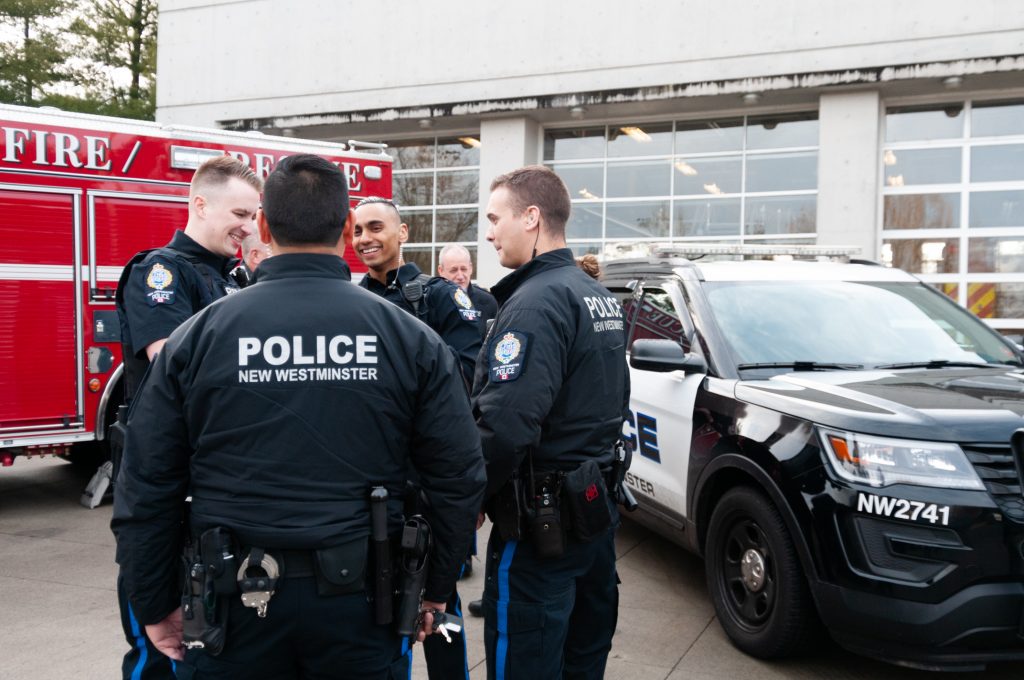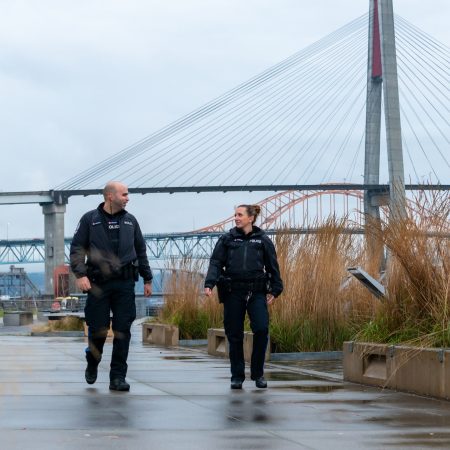
Features
Peer support 2.0
The future of law enforcement wellness
August 4, 2020 By Steven Bill, with Art Wlodyka
 Photo:Art Wlodyka/New Westminster Police Department
Photo:Art Wlodyka/New Westminster Police Department The world keeps turning, despite 2020’s best efforts to slow it down, with police officers and other first responders seeing their already considerable workloads increase or change in significant ways. While the routine traffic stops, report calls and minor disputes may have slowed, each one presents a new challenge as PPE (personal protective equipment) and distancing requirements have given the mundane a new risk factor.
As the pandemic has gone on, police have now seen an influx in mental health crisis calls. Many of the most vulnerable have been isolated for months, seen a reduction in social support and resorted to extreme measures such as increased illicit substance use and even suicidality. And now, at the time of writing this, officers have a compounded threat and worry with the increased social and race-based unrest, plus police officer scrutiny brought on by the tragic death of George Floyd in Minneapolis and its aftermath.
As police departments navigate these shifts, literal and figurative, they must constantly re-evaluate the programming and support they make available to their membership. Gone are the days of “suck it up,” but how do well-intentioned chiefs, deputies and wellness co-ordinators navigate the overwhelming number of wellness practices, tools and techniques everyone else seems to swear by?
We spoke with Art Wlodyka, M.A. Counseling Psychology and CISM/peer support co-ordinator with the New Westminster Police Department (NWPD) in British Columbia, about how his team is handling these recent events. We also spoke about what supports and policies he sees as being critical to handle officer wellness today as well as into the future.
Steven Bill (SB): Art, I know you have been a vocal and effective advocate for officer wellness initiatives, and have had a number of pieces published previously, but we want to look at the issues police officers are facing right now, as well as what you think the landscape of wellness programming will look like as we emerge from the COVID-19 and the police accountability protests we’ve seen in the first half of 2020.
To get us started, can share what’s working for you at NWPD — whether it’s a traditional type of program, or something out-of-the-box?
Art Wlodyka (AW): We have a newly created organizational wellness officer overseeing a number of new initiatives, as well as an active Critical Incident and Peer Support team. One of the best things I have seen is getting proactive messaging out about mental health and services available to our staff from our wellness officer in a variety of ways. These include washroom posters and memes on our internal network. Officers have responded really well to that. I have also seen a shift in officers feeling comfortable approaching myself or other peer team members to talk about a number of stressors happening in their lives. This covers everything from relationship issues, looking for resources for their kids, discussing burnout, some organizational stressors and just mental health in general. People also come by regularly looking for referrals to counsellors or psychologists. To meet that need our team has doubled in size — from four officers in 2015 to eight in 2020, which also includes a civilian. This is for a staff of about 160.
I would say the jury is no longer out on peer support; it has been well studied and found to be effective at engaging frontline staff and acting as a ‘first step’ toward seeking more formalized assistance like an EAP (Employee Assistance Program).
We’ve also been given some flexibility in determining what a peer support interaction looks like, which I think is important and something we’ll be looking at more in the future. The debriefs, phone calls and coffee chats will still be there, but we are really trying to meet people where they are at. For example, an officer that I didn’t know very well, who had been involved in a police shooting… I was able to go out for a run with him and connect that way. There was no potential awkwardness of sitting in a room across from someone you didn’t know well. It was just getting out, moving, training together, and so talking and sharing came organically.
As part of a role within a provincial psychosocial team called the Mobile Response Team (MRT), I also had the opportunity to co-facilitate a first responder retreat in northern B.C. During this retreat peers were able to connect with one another through open and honest conversations, process some difficult events in their lives, and just have a bit of fun and forget all of the challenges they deal with on a daily basis. Feedback from this event was very positive and we are working with our partners to explore additional opportunities like this.

Photo:Art Wlodyka/New Westminster Police Department
SB: What have been the most challenging situations you’ve faced while running the wellness program?
AW: Right now, a lot of attention — not just at NWPD but also in the sector as a whole — is on spouse and family support, and connecting loved ones with resources and opportunities. How do you engage these people or equip them with the right phone numbers or contact people, make sure that information is current, but also recognize the anxiety or concerned state they may be in when they make the decision to reach out either for themselves or on behalf of their loved one? There are a lot of factors to consider: privacy, anonymity, record-keeping, relevant resources and so on. So that is an area where we have fortunately had some success stories emerge from, but also some instances where people weren’t sure where to turn or what the right process was. We’ve had some success holding some local family seminars but are always looking at better ways to connect and include spouses and families with appropriate support mechanisms.
Another significant challenge we’ve had is staying connected to officers who have been off work with long-term physical or psychological injuries. Even with the increase in team size — and the best of intentions — it’s sometimes difficult to stay in contact. Each of these officers and staff members also have different needs and differing expectations around support and contact. Navigating these issues, along with our own full-time positions, can be challenging. The creation of our new wellness officer position has helped, along with participation at all levels of leadership, to stay connected to those officers. Officer re-integration programs and greater access to first responder treatment programs is also helping to address this need.
We are now setting up a system now where we can better manage and track who has been met with, and have automated reminders that alert the team when someone has gone a certain number of days without a peer support interaction.
SB: Turning to the future now, what ideas do you have to enhance your current offerings, and what advice would you give to other leaders looking to start up or revamp their internal support services?
AW: In conjunction with our wellness officer, we are always on the lookout for improving and expanding our programming. Recently, we’ve formed a group of CISM/Peer Support/Wellness Co-ordinators from across B.C. who meet monthly to discuss challenges and successes, so we’re able to benefit from that collaboration and groupthink.
We continue to work on strategies to proactively engage our officers on a consistent basis in ways that they are able to relate to.
We are now setting up a system now where we can better manage and track who has been met with, and have automated reminders that alert the team when someone has gone a certain number of days without a peer support interaction. Again, we are not trying to force any check-ins on anyone; we just want to make sure we are not missing anyone and ensure people have the support they need. We are also excited about the simplicity of the program in being able to ask for contact with a simple click of a button, and not have to look up specific phone numbers for specific people to ask for help.
We’re excited to implement this, and I’m personally very interested in a program that will also allow us to spend more time with colleagues and supporting them, and less time administratively co-ordinating follow-ups and collecting reports.
SB: Any last words of wisdom for chiefs and wellness co-ordinators?
AW: Continue to find new and innovative ways of supporting colleagues. While there is certainly a risk management business case around mental health and wellness supports, we must handle this in ways that feel meaningful and real to officers. Sometimes it’s around addressing specific stressors such as “staff shortages” where officers are reallocated to support the biggest need, such as patrolling the frontlines. Sometimes it’s about investing in new programs and taking chances to try something new, rather than sitting on the fence and waiting to see “what is everyone else doing?” I have seen great examples of strong leadership during the recent pandemic and look forward to open and honest dialogues at all levels of leadership moving forward.
Steven Bill is the co-ordinator of communications and new media for the Thunder Bay District Health Unit (TBDHU). He has a passion for helping organizations understand what their driving purpose is, and has been an important part of TBDHU’s nationally-recognized COVID response campaigns.
Art Wlodyka is a New Westminster Police Department police officer and mental health clinician. He is the founding member of a Police Mental Health Unit in 2013. Since then, he has assisted hundreds of individuals in crisis, and was awarded a Chief Constable’s Commendation in 2014.
Print this page